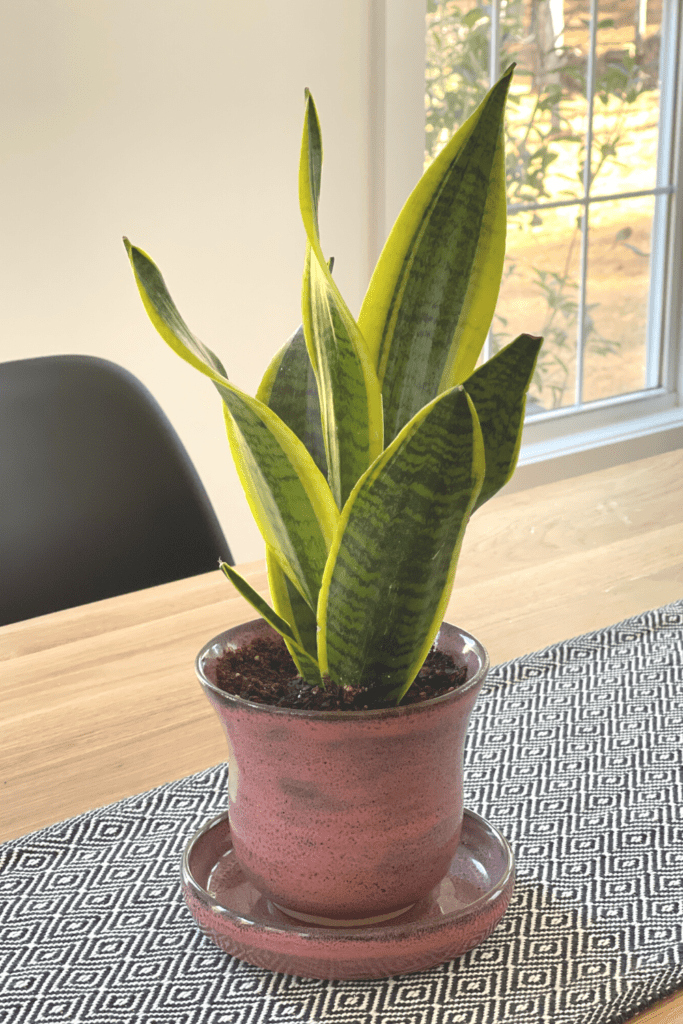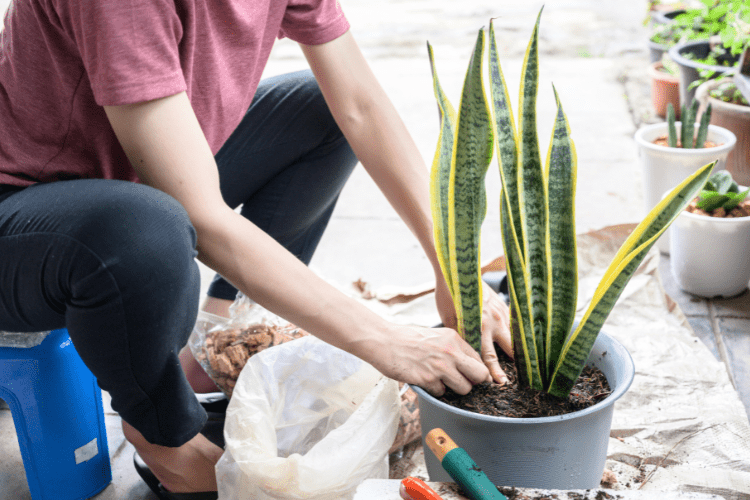Plant propagation makes new specimens from a single parent plant. Snake Plant propagation can be easy, offering you plenty of small plants to increase the aesthetics of your home and its air quality.
Learn how to perform snake plant propagation and how to give your snake plants the best care with this detailed guide. We’ll give an overview of the species, ideal growing conditions, and the right soil, watering, and lighting to use with snake plants.
What is a Snake Plant?
Snake plants – otherwise known as Sansevieria trifasciata or, more frightening, Mother-in-Law’s Tongue – is an evergreen native to Africa and Asia.
The most notable feature of Snake plants is upright, sword-shaped leaves that can sometimes look artificial. These plants are extremely low maintenance and very forgiving of being without water.

Can I Grow Snake Plants Indoors?
Snake plants are native to warmer clients, making them great indoor house plants. However, they do best when grown in the more mild indoor temperatures, between 60 and 80 degrees.
They can help purify the air indoors. However, the plants are slightly toxic if consumed. There is poison in the leaves that can cause the tongue to go numb and swell.
Can Snake Plants Grow Outdoors?
Snake plants cannot grow full-time outdoors. But you can put them outside in the summer if you live in zones 8 through 11.
Factors that affect how your Snake plants do outdoors include the placement of your plants, the light and water they get, and the outdoor temperatures. Pests, humidity, and fertilization also impact your plants’ outdoor growth habits.
What Soil is Best for Snake Plants?
The best type of soil for Snake Plants will get damp when you water the plant, which allows the roots to absorb water. But the soil should be loose enough that it can also drain. Ensure the pot has drain holes at the bottom.
You can buy a ready-made mix, like this one. Or you can make your own using various ingredients.
Or you can consider combining regular potting soil with a succulent blend which gives you the best of both worlds.
Your soil should have regular topsoil. But you can also add garden soil or combine both types of soil. Garden soil is dense, which can affect how it drains. But it also has higher nutrient content than natural microorganisms.
You can make a mix using 60% soil – less than 50% for garden soil. Another option is to use a soil-let potting mix rather than 100% soil. Peat moss has a slightly acidic pH and a fluffy texture. Coir is another alternative, also known as coco peat or coconut fiber due to being a compost of coconut husks.
Sand can make it easier for oxygen and water to reach the flower roots and for water drainage. But too much is bad, so use small quantities of 10% to 15% of the soil mix. Gravel can be an alternative to sand or an addition laid at the pot’s bottom.
Perlite can improve water drainage, pore space, and soil aeration. This volcanic rock resembles Styrofoam balls or porous, white popcorn. Substitutes include aquatic plant soil, chicken grit, rice hulls, pumice, or recycled glass. Use up to 40% of Perlite in your soil mix.
Another useful volcanic rock to add to your soil mix – up to 40% – is pumice. These pitted pored rocks increase the carbon dioxide and oxygen and, when used with snake plants, decrease the soil density while retaining nutrients and moisture in the pores.
Compost can introduce good bacteria and microorganisms that create humus by helping the organic matter decompose. Although Snake plants can do without chemical fertilizers or compost, including compost in the soil can protect your plants from pests and diseases.
Do I Fertilize Snake Plants?
You can fertilize Snake Plants with a balanced ratio of fertilizer with the three primary nutrients – (N) nitrogen, (P) phosphorus, and (K) potassium.
Choose a 10-10-10 NKP fertilizer, which means it contains 10% of each of the three ingredients. And the rest of the ingredients are secondary nutrients and fillers.
Plants receiving full sun require fertilization every other month from spring to early fall. And for plants that get low light, you can use single fertilization in late spring or summer.
You can pick an organic (naturally occurring materials) or synthetic (human-made) fertilizer in concentrated liquid, pre-diluted liquid, spikes, or granular.
One option is a premade solution like this one that you can use once a month.
Signs that your Snake plant needs fertilization include drooping or light green to yellow leaves and a lack of vigor. In addition, fertilizer should be applied to the dirt slowly.
Propagating Snake Plants in Water
Using water to propagate snake plants is one of the easiest and most convenient methods for growing new plants. This method requires putting root cuttings in water rather than dirt.
It’s an excellent choice for leaves that have fallen off from breaking or bending. Or you could also use the excess leaves you’ve pruned off your plant.
When pruning leaves or taking a cutting for propagation, use a sharp cutting tool, such as a knife or scissors. Make a clean cut of the leaf close to the soil. Large leaves can be cut into sections and placed into water separately.
Then it’s time to put the bottom part of the leaf in water. Some people prefer to dip the cutting into a rooting hormone before submersion; this is optional.
The water should cover at least 25% of the leaf. But be sure that you put the leaves facing the same direction that they grew in the dirt. The leaf can only grow roots if you’re using the right end.
A V-shape cutting can give you the best results by giving you a larger cut edge surface area while keeping the edges from pressing against the bottom of the container. Remember that you’ll want to use something heavy to hold the top-heavy leaves, such as a mason jar or tall vase.
Put your vase in a warm room with lots of indirect light. And change the water every week or when the water becomes cloudy. It can take up to two months or longer before you get roots or shoots – growths coming off the roots.
The plants are ready for transplantation into the soil once the roots appear. The cutting needs to be as deep in dirt as in the water.

Propagating Snake Plants in Soil
Propagating your snake plants in soil is preferred if you want to get more cuttings out of one leaf with little effort.
Start by cutting the leaf from the plant near the dirt line with a sharp, clean knife. Then, use the knife to cut the leaf into several smaller pieces.
Let these pieces air out over a few days until they start to callous, which prevents bacteria from entering the leaf and causing rot.
Next, position the cuttings in the same direction they grew naturally and put them into well-draining soil – succulent soil works excellently. If you want to use rooting hormone on your cuttings, do so before putting them in the dirt.
You can expect the cuttings to start growing roots within a month and new growth for the plants the following month.
I used my own snake plant to make a new plant for my sister as a gift. I pulled out the whole plant from the soil, cut one of the pups (this is the new growth) from the root, and replanted it in new soil. In no time, she had her own healthy plant.
What Size Pots do Snake Plants Like?
Snake plants are prone to rot when left in water or over-watered, so your pots need good drainage.
Terracotta pots make an excellent choice due to their porous nature, which helps the soil dry out better. Pots that are heavy and have a drain hole at the bottom help with the top-heaviness.
Snake plants don’t mind a smaller pot and they can grow tightly together. It’s recommended to only size up one size pot when you’re repotting your plants.
This is another reason it makes them ideal for house plants. You don’t need to make space for a giant pot anywhere.
How Long do Snake Plants Live?
Snake plants can last a decade or longer with the right care. You can expect the average lifespan for a Snake plant to be 10 to 15 years.
But that doesn’t mean you’re limited to that time frame. You can make snake plants last two decades or even up to 25 years if you give them the right care.
How Much Sunlight Do Snake Plants Need?
Snake plants can tolerate low or high light exposure, depending on humidity and temperature.
Low lighting can cause snake plants to grow slowly, while they have a faster rate when put under indirect, bright light.
However, Snake plants cannot handle direct sunlight, which will burn the plant leaves. But droopy yellow leaves can mean your plant needs more sunlight. Other symptoms of low light are soggy leaves, wet soil, and root rot.
A location positioned 4′ to 6′ from a window can provide the appropriate indirect light your plants need for the proper amount of time. Your plants will require a minimum of 8 to 10 hours of light daily.
How Often Do I Water Snake Plants?
Snake plants need water once a week, although smaller plants can go up to two weeks. Larger plants can need water every two to three days. You can also judge when your plants need water by feeling the dirt. Water when it’s dry.
Common Problems with Snake Plants
The biggest issue with snake plants is overwatering them. These plants cannot tolerate the roots staying wet, which can cause them to experience rotting.
Adding the right amount of low watering – when the top two to three inches of soil are dry – and having a well-draining pot can help prevent rotting. You also must choose the right soil medium, like succulent or soilless potting mix.
Another issue that can arise during the propagation of cut Snake Plants is that the open wounds left on the specimen plant can risk getting infected with fungi and bacteria. Keeping utensils and pots clean and sterilized can reduce the risk of bacteria transfer.
Freezing, frost, and temperatures under 50 degrees can cause the edges and tips of the plants to turn brown, while the rest of the plant starts to yellow.
Snake Plant Propagation
You can make new plants by causing temporary harm to your parent plant by using the process of propagation. When you propagate a Snake plant, you can have several additional plants with little to no work. Snake plant propagation can be done through water or soil.
It’s super easy to add even more gorgeous plants to your home using snake plant propagation.




